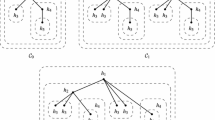Abstract
In the attempt to have a framework where the computation is done by communication only, we consider the biological phenomenon of trans-membrane transport of couples of chemicals (one say symport when two chemicals pass together through a membrane, in the same direction, and antiport when two chemicals pass simultaneously through a membrane, in opposite directions). Surprisingly enough, membrane systems without changing (evolving) the used objects and with the communication based on rules of this type are computationally complete, and this result is achieved even for pairs of communicated objects (as encountered in biology). Five membranes are used; the number of membranes is reduced to two if more than two chemicals may collaborate when passing through membranes.
Similar content being viewed by others
Explore related subjects
Discover the latest articles, news and stories from top researchers in related subjects.References
Alberts, B., et al.,Essential Cell Biology. An Introduction to the Molecular Biology of the Cell, Garland Publ. Inc., New York, London, 1998.
Dassow, J. and Pâun, Gh.,Regulated Rewriting in Formal Language Theory, Springer-Verlag, Berlin, 1989.
Martin-Vide, C., Pâun, Gh. and Rozenberg, G., “Membrane Systems with Carriers,”Theoretical Computer Science, 270, pp. 779–796, 2002.
Pâun, Gh., “Computing with Membranes,”Journal of Computer and System Sciences, 61, 1, pp. 108–143, 2000.
Handbook of Formal Languages (Rozenberg, G. and Salomaa, A., eds.), Springer-Verlag, Berlin, 1997.
Author information
Authors and Affiliations
Corresponding author
Additional information
Andrei Pâun: He graduated the Faculty of Mathematics of Bucharest University in 1998, received his M.Sc. degree from The University of Western Ontario in 1999, and since then he is a PhD student in the Computer Science Department of University of Western Ontario, London, Canada (under the guidance of prof. Sheng Yu). The topic of his thesis is Molecular Computing (especially, DNA and Membrane Computing), but his research interests also include neural networks, implementing automata, combinatorics on words.
Gheorghe Pâun: (the proud father of two sons, including the first author of this paper) He is a member of the Romanian Academy, working as a senior researcher in the Institute of Mathematics of the Romanian Academy, Bucharest, and as a Ramon y Cajal researcher in Rovira i Virgili University of Tarragona, Spain. He is one of the most active authors in (the theory of) DNA Computing, (co)author of many papers in this area, (co)author and (co)editor of several books. In 1998 he has initiated the area of Membrane Computing. Other research interests: regulated rewriting, grammar systems, contextual grammars, combinatorics on words, computational linguistics.
About this article
Cite this article
Pâun, A., Pâun, G. The power of communication: P systems with symport/antiport. New Gener Comput 20, 295–305 (2002). https://doi.org/10.1007/BF03037362
Received:
Published:
Issue Date:
DOI: https://doi.org/10.1007/BF03037362




